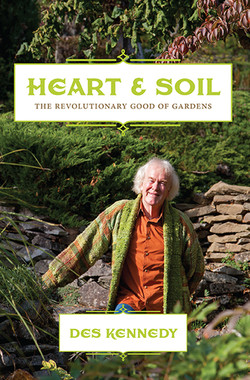Читать книгу Heart & Soil - Des Kennedy - Страница 18
На сайте Литреса книга снята с продажи.
ОглавлениеBarrowing Along
Sometimes it feels as though the gardener’s principal occupation is the picking up of materials, often heavy or bulky, and transporting them across uneven ground in order to deposit them someplace else. In this work, few tools prove more dutiful than the wheelbarrow. Known as far back as ancient Greece and China, for thousands of years the wheelbarrow has done its work with primitive but marvellous simplicity. More essential than sexy, it trundles faithfully behind the scenes while other fads and fashions flutter for the cameras.
Around our workplace, we’re a two-wheelbarrow family. One unit is built like a Sherman tank, with rugged steel frame and heavy-gauge steel bucket. During the thirty-plus years we’ve had it, this brute has moved more weight than the builders of Stonehenge. Its old bucket is now perforated with rust holes, but it barrows on and I dread the day when it can go no farther. The other is a younger and flimsier affair with a smaller wheel, wooden frame and a lighter-gauge steel bucket. It’s what passes for a wheelbarrow nowadays and dozens of its type line the entranceways of big-box stores in spring. Some have a polypropylene bucket. Some have two wheels. None impress. For sturdiness is of the essence, and a good wheelbarrow—like our old trustworthy—should last for decades, if not generations. The built-in obsolescence of the flimsy barrows now on offer is an insult to the great legacy of barrowing and contemptible to any true-blue barrow-man or -woman.
One of my main barrow tasks is wheeling in the winter firewood. No road penetrates our woodlot and the big barrow is perfect for navigating narrow footpaths and rolling over tree roots (something at which low-slung and long-snouted ersatz barrows are hopeless). It’s work enough getting in the hundred-plus loads required to fill the woodshed every autumn, without the added aggravation of periodically ramming into a protruding rock or root.
Moving massive stones from place to place often requires innovative measures. If a stone’s too heavy to be picked up and placed in the barrow, I use a roll-and-jerk technique, much like an Olympic weightlifter. The barrow is laid on its side and the stone rolled onto the edge of the bucket. Then bucket and stone are jerked upright together. If a hernia isn’t induced by the lifting, it may be by subsequent wobbling around with the overloaded barrow. Tipping techniques can be tricky too. Unless meticulously tipped, a load of precious compost or fresh cement may disgorge sideways, entirely missing the intended point of deposition.
The Old English noun “barrow” also means a hill or hillock, but wheelbarrows and hills don’t go well together. Pushing a loaded barrow uphill can bring a dismaying sense of gradual momentum loss, followed by teetering uncertainty as inertia’s about to defeat you, then a grunting stall. Getting a running head start at an impending incline sometimes helps. Descending a hill, the opposite’s true, as gravity tries to wrench the barrow from your grip and send it careening downhill. Disaster can sometimes be averted by pressing the barrow legs into the earth to try to brake the runaway barrow. On wet or icy ground the downhill slide may be a thing of terrifying beauty.
Mastering the intricacies of barrow operation can take longer than getting a medical diploma. Novices may be observed repeatedly picking up items and carrying them over to a barrow, rather than wheeling the barrow to where the items are. Some people take years to figure out it’s easier to point a barrow in its intended direction before loading it up. They’ll load to the brim and then get a herniated disc trying to turn the barrow around. Or they’ll load up in a spot so tight it can’t be turned around at all. Dragging a barrow backwards indicates an education considerably short of complete. Strategic reversing, on the other hand, is indicative of a sophisticated wheeler. When our woodshed’s almost full, I take satisfaction in first wheeling around and then reversing into the shed’s narrow passage so that pieces can be conveniently unloaded without a knee-knocking barrow intervening.
In the end, disposition of an old wheelbarrow requires careful consideration. Our first barrow was an ancient contraption with a steel wheel but no tire and a flat wooden bed into which wooden sides could be slotted. When we replaced it long ago, we burned it—only to later discover in a posh gardening magazine a photograph of an identical model gaily painted and planted with nasturtiums and available for a small fortune. So when in due course another old barrow came our way, we gussied it up with fresh paint, filled its bucket with objets trouvés and made it an installation in the flower garden. This is what passes for the wisdom of age.
But one could do far worse than spend one’s allotted time as a barrow-person. The fresh air. The exercise. The mental equilibrium. Having a wheelbarrow is almost like having a personal trainer. Then, after a long life of barrowing, it would be fitting to spend your declining days like one of those wizened oldsters pictured in “developing” countries, being wheeled around the marketplace while reclining in a wheelbarrow. That would be the wheel deal.
